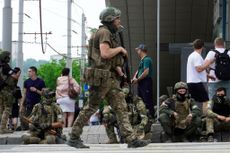A brief timeline of Russia's war in Ukraine
How the Kremlin's plan for a quick conquest turned into a quagmire


Russia had a plan to conquer Ukraine in about a week. A year after it tried to execute that plan, Russia's army was in a fierce, bloody battle for a small, strategically insignificant city it had already reduced to smoldering rubble. Six months later, Moscow was on the defensive, engaged in World War I–style trench warfare, with casualties to match.
Here are some key moments in Russia's war in Ukraine.
Feb. 24, 2022 — Russia invades
Early on a Thursday morning, Russian President Vladimir Putin announced the start of his "special military operation" to "demilitarize" and "denazify" Ukraine. Within hours, Russian missiles rained down across Ukraine and Russian forces invaded from the north, east and south. Ukraine put up fierce resistance — and got its first rallying cry later in the day when a group of 13 border guards on tiny Snake Island were told by a Russian warship to surrender. "Russian warship, go f--- yourself," the guards responded.
Subscribe to The Week
Escape your echo chamber. Get the facts behind the news, plus analysis from multiple perspectives.

Sign up for The Week's Free Newsletters
From our morning news briefing to a weekly Good News Newsletter, get the best of The Week delivered directly to your inbox.
From our morning news briefing to a weekly Good News Newsletter, get the best of The Week delivered directly to your inbox.
Feb. 25 — Zelenskyy rallies Ukraine
Amid the chaotic opening hours of Russia's invasion, rumors spread that Ukrainian President Volodymyr Zelenskyy had fled the country — the U.S., in fact, had offered to extract him before Kyiv fell. ("I need ammunition, not a ride," Zelenskyy reportedly replied.) Zelenskyy and other top officials posted a video from the streets of central Kyiv early Friday, assuring Ukrainians that "we are all here defending our independence, our state, and it will remain so."
March 2 — Russia captures Kherson
As Moscow's northern offensive floundered, Russian forces were making progress in the southeast. Kherson, the capital of Kherson Oblast, was the first major city to fall in Russia's unsuccessful coastal push toward Odesa.
March 29-30 — Russia abandons Kyiv offensive
Russia's first tacit acknowledgment its invasion wasn't going well was its "planned regrouping of troops" away from Kyiv and surrounding areas.
April 3 — Ukraine discovers Russian atrocities in Bucha
Russia's hasty retreat from Kyiv's suburbs revealed evidence of summary executions, beheadings, torture, rape, and other atrocities. The savagery was particularly evident in Bucha, and Putin reportedly awarded medals of valor to the brigade that brutalized the town.
April 14 — Ukraine sinks Russian flagship Moskva
The guided-missile cruiser Moskva, Russia's Black Sea flagship and the warship instructed to "go f---" itself, sank after an explosion that Moscow blamed on a fire and Ukraine attributed to a strike by its Neptune anti-ship missiles. The sinking of the Moskva was an embarrassing blow to Russia, whose warships pulled back from Ukraine's coast afterward, reducing the threat of an amphibious attack on Odesa.
April 18-19 — Russia officially pivots to 'next phase' of war
Russia shifted its troops from the Kyiv offensive to Ukraine's eastern Donbas region, and the amassed forces launched a broad attack there on April 18. Ukraine called it a "new phase of the war." Moscow announced the "next phase" of its invasion on April 19.
May 18 — Sweden and Finland apply to join NATO
Sweden and Finland, citing Putin's bellicosity toward his neighbors, dropped their longstanding official neutrality and applied on the same day to join the North Atlantic Treaty Organization. Putin had listed NATO expansion among his reasons for invading Ukraine.
May 20 — Russia completes bloody conquest of Mariupol
Russian forces attacked Mariupol on the first day of the invasion. Ukrainian defenders put up a fierce fight, eventually making a last stand at the sprawling Azovstal steelworks complex. The final Azovstal defenders surrendered May 20. Russia's brutal siege of Mariupol included a March 9 missile strike on an active maternity hospital and the bombing of Mariupol's Drama Theater on March 16, which killed hundreds of the people sheltering inside. Mariupol completed Russia's "land bridge" to occupied Crimea.
July 3 — Russia captures Lysychansk, all of Luhansk Oblast
Russia's push to seize the Donbas effectively culminated with its July 3 capture of Lysychansk, giving Moscow complete control of the Luhansk province. Ukraine had withdrawn from Lysychansk's sister city, Sievierodonetsk, on June 24, after a weeks-long battle in which Russia pounded the city to rubble.
Aug. 29 — Ukraine launches first big counteroffensive
Ukraine began a campaign to retake Kherson and push Russian forces east of the Dnipro River. The counteroffensive's launch followed months of foreshadowing and weeks of preparatory strikes on Russian supply lines and ammunition and fuel depots.
Sept. 21 — Putin declares 'partial mobilization'
Putin, bowing to pressure from military leaders, announced a "partial mobilization" to replenish Russia's depleted invasion force with up to 300,000 conscripts. The draft was unpopular and sparked unusually large protests and an exodus of hundreds of thousands of draft-eligible Russian men.
Sept. 30 — Russia 'annexes' 4 regions
Putin announced the annexation of the partially occupied Luhansk, Donetsk, Kherson and Zaporizhzhia provinces three days after Russia declared victory in referendums it staged on Feb. 23. The referendums and illegal annexation were dismissed as shams by the West and Ukraine.
Oct. 2 — Ukraine recaptures Kharkiv in lightning strike
With Russian forces amassing in Kherson to repel Ukraine's southern counteroffensive, Ukrainian forces launched a surprise attack on northern Kharkiv province on Sept. 6, starting a three-week rout that recaptured hundreds of square miles including the key cities of Izium, Kupyansk and Lyman.
Oct. 8-10 — Ukraine disables Crimea bridge, Russia retaliates
In a blow to Russian pride and logistics, a truck bomb exploded on the $3.6 billion Kerch Strait Bridge connecting Russia to Crimea, rendering it impassible for months. Ukraine eventually claimed credit for the attack, and Moscow retaliated by launching waves of missile and drone strikes against civilian targets in cities across Ukraine.
Nov. 11 — Ukraine recaptures Kherson
Ukrainian forces poured into a cheering Kherson two days after Russia ordered its troops to withdraw across the Dnipro on Nov. 9. The recapture of the only regional capital Moscow was able to occupy during its invasion was a huge embarrassment for the Kremlin.
Feb. 9, 2023 — Russia launches spring offensive
Russian forces began a renewed campaign to capture the entire Donbas region, attacking heavily fortified Ukrainian positions using tens of thousands of new conscripts. Russia's "troops are ill-equipped and ill-trained, and because of that, they're incurring a lot of casualties," U.S. Defense Secretary Lloyd Austin said Feb. 16.
May 21 — Russia claims conquest of Bakhmut
The battle for Bakhmut, the longest and bloodiest of the war, ended a year after it began, long after the city had become more symbolically important than strategically significant. When Russian forces floundered, the private militia known as the Wagner Group took over the fight. Wagner claimed victory over the gutted ruins of Bakhmut on May 21, after having lost at least 10,000 fighters in six months. Ukraine has continued fighting for Bakhmut with some success.
June 8 — Ukraine launches second big counteroffensive
After months of hints, feints, pleas for discretion, and deliveries of Western armaments, Ukraine launched its counteroffensive in eastern and southeastern Ukraine in early June. Within days, Ukraine had recaptured several small villages near the Donetsk-Zaporizhia border, but Russian defenses, including heavy fortifications and miles-wide minefields, have kept Ukraine's progress slow.
June 23-24 — Wagner mutinies
Wagner eventually handed control of Bakhmut to regular Russian forces and then pulled back into Russia, where group leader Yevgeny Prigozhin staged a brief mutiny. The short-lived uprising rattled Putin's government and marked the end of Wagner's participation in the Ukraine war. Prigozhin is said to have died in a suspicious plane crash on Aug. 23.
Aug. 24 — Ukraine starts raiding Crimea
Ukrainian special forces staged an overnight maritime raid on Crimea, the first of several brief incursions into the heavily fortified Russian-occupied peninsula. The commandos used jet skis to avoid detection, attacked an electronic warfare station that had protected Crimea from drone and missile attacks, and planted a Ukrainian flag. After an early October raid, Russia claimed to have captured one Ukrainian commando.
Sept. 13-22 — Ukraine strikes Russia's Black Fleet headquarters
A Ukrainian missile strike on Sept. 13 hit and badly damaged a submarine and ship dry-docked at Russia's Black Sea Fleet main port in Sevastopol, Crimea. On Sept. 22, Ukraine struck fleet headquarters. Ukraine's military said the strike killed 34 senior Russian officers, including fleet commander Adm. Viktor Sokolov. After Russia released video appearing to show Sokolov after the attack, Ukrainian defense intelligence official Andriy Yusov said "many brass hats were liquidated" in the strike but Sokolov's death hadn't yet been confirmed, though "he's definitely anything but fine." Russia has moved much of its fleet to Russia, giving Ukraine more leeway in the Black Sea.
Nov. 1 — 'Stalemate'
Ukrainian commander in chief Gen. Valery Zaluzhny told The Economist that after months of incremental gains but no breakthroughs, Ukraine and Russia "have reached the level of technology that puts us into a stalemate," just like in World War I. Zelenskyy reprimanded Zaluzhny for "easing the work of the aggressor" with his fatalism, though some Western analysts agreed with his prognosis, to a point. "War is not a game of chess," with a finite number of pieces, Yale University historian Timothy Snyder told The Guardian. "The reason why I hate the stalemate analogy is that it suggests we can't just drop five more queens on the Ukrainians board, and we can do it any time."

Continue reading for free
We hope you're enjoying The Week's refreshingly open-minded journalism.
Subscribed to The Week? Register your account with the same email as your subscription.
Sign up to our 10 Things You Need to Know Today newsletter
A free daily digest of the biggest news stories of the day - and the best features from our website
Peter has worked as a news and culture writer and editor at The Week since the site's launch in 2008. He covers politics, world affairs, religion and cultural currents. His journalism career began as a copy editor at a financial newswire and has included editorial positions at The New York Times Magazine, Facts on File, and Oregon State University.
-
 Today's political cartoons - December 2, 2023
Today's political cartoons - December 2, 2023Cartoons Saturday's cartoons - governors go Gotham, A.I. goes to the office party, and more
By The Week US Published
-
 10 things you need to know today: December 2, 2023
10 things you need to know today: December 2, 2023Daily Briefing Death toll climbs in Gaza as airstrikes intensify, George Santos expelled from the House of Representatives, and more
By Justin Klawans, The Week US Published
-
 5 hilarious cartoons about the George Santos expulsion vote
5 hilarious cartoons about the George Santos expulsion voteCartoons Artists take on Santa versus Santos, his X account, and more
By The Week US Published
-
 Ukraine's counteroffensive is making incremental gains. Does it matter in the broader war?
Ukraine's counteroffensive is making incremental gains. Does it matter in the broader war?Speed Read
By Peter Weber Published
-
 How the collapse of the ruble could impact the war in Ukraine
How the collapse of the ruble could impact the war in UkraineTalking Point Will it hurt Putin's war or is it merely symbolic?
By Justin Klawans Published
-
 British spy chief, Wagner video suggest Prigozhin is alive and freely 'floating around'
British spy chief, Wagner video suggest Prigozhin is alive and freely 'floating around'Speed Read
By Peter Weber Published
-
 Putin and Prigozhin offer rival explanations for Wagner's brief rebellion
Putin and Prigozhin offer rival explanations for Wagner's brief rebellionSpeed Read
By Peter Weber Published
-
 Who was Yevgeny Prigozhin, the man who defied Putin and paid the ultimate price?
Who was Yevgeny Prigozhin, the man who defied Putin and paid the ultimate price?Why Everyone’s Talking About Prigozhin launched an attempted assault against Moscow at the end of June. By the end of August, he was dead.
By Justin Klawans Last updated
-
 How will Wagner's short-lived mutiny affect the Ukraine invasion?
How will Wagner's short-lived mutiny affect the Ukraine invasion?Today's Big Question Yevgeny Prigozhin's 24-hour rebellion against Moscow is over for now, but its aftershocks may just be starting
By Peter Weber Published
-
 The future of the Wagner Group is murky
The future of the Wagner Group is murkySpeed Read
By Catherine Garcia Published
-
 Wagner Group stops armed rebellion toward Moscow
Wagner Group stops armed rebellion toward MoscowSpeed Read
By Justin Klawans Published










